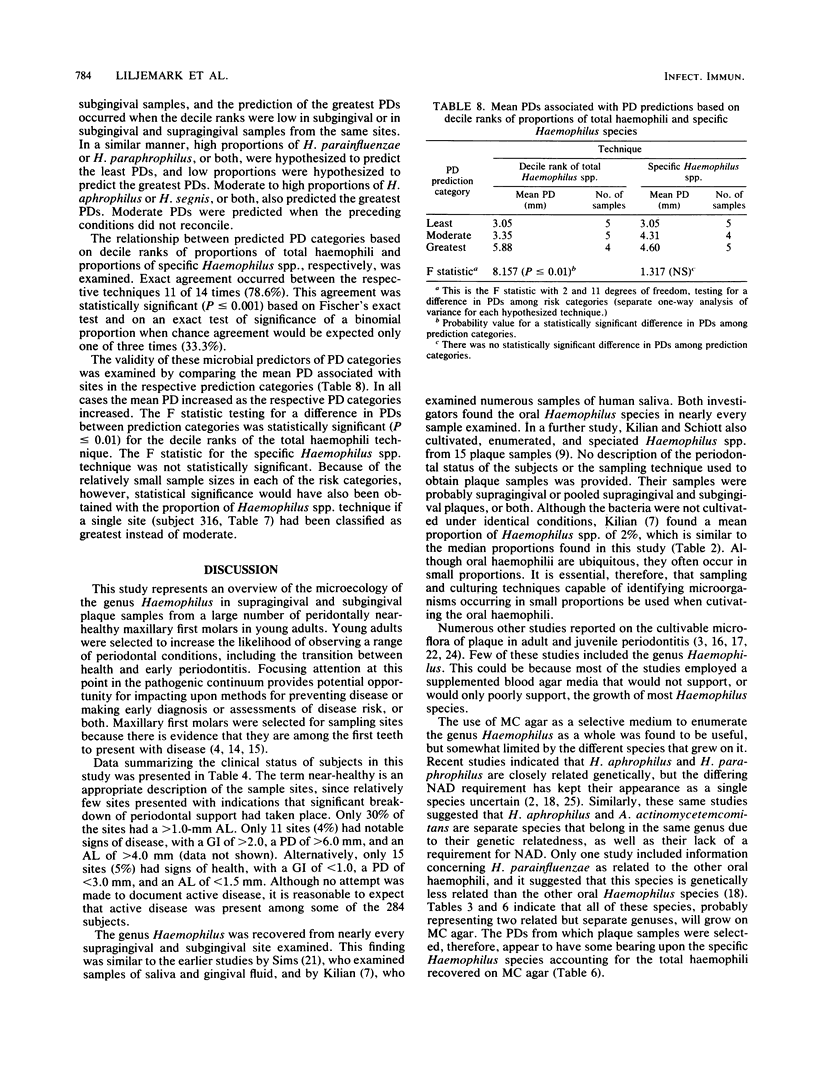Abstract
The periodontal status of maxillary first molars in 284 young adults demonstrating near-health to early disease was evaluated, and supragingival and subgingival plaque samples were collected. Plaque samples were processed anaerobically, enumerated microscopically for bacterial morphotypes, and cultivated on various media to enumerate the microflora. Although haemophili were ubiquitous (recovered in 98.5 and 96.2% of the supragingival and subgingival plaque samples, respectively), 50% of the respective samples had proportions of less than or equal to 1.5% and less than or equal to 0.33% total Haemophilus spp. based on total cultivable microflora. To study the distribution of Haemophilus spp., 377 colonies were identified from modified chocolate agar (selective for oral haemophili) from 14 supragingival and corresponding subgingival samples from 14 subjects. The most prevalent species, Haemophilus parainfluenzae, was found in significantly higher proportions, based on total haemophili on modified chocolate agar, in supragingival and subgingival samples from teeth with shallower probing depths (less than or equal to 3.0 mm) versus deeper probing depths (greater than or equal to 3.0 mm). Additional statistically significant findings included Haemophilus segnis in higher proportions in supragingival samples from deeper sites, Haemophilus aphrophilus in higher proportions in subgingival samples from deeper sites, and Haemophilus paraphrophilus in higher proportions in subgingival samples from shallower sites. Scatter diagrams illustrating the bivariate distributions of proportions of haemophili with proportions of dark-pigmented Bacteroides spp., spirochetes, and streptococci demonstrated that high proportions of haemophili were never recovered from sites with high proportions of Bacteroides spp. or spirochetes. All levels of haemophili, however, were recovered from sites with all levels of streptococci. Two potential systems for interpreting haemophili data were hypothesized for predicting periodontal probing depths. There was highly significant agreement between the two systems. Small but statistically significant correlations were found between the gingival index, probing depth, and attachment level, and proportions of total Haemophilus species in the respective samples.
Full text
PDF








Selected References
These references are in PubMed. This may not be the complete list of references from this article.
- Darwish S., Hyppa T., Socransky S. S. Studies of the predominant cultivable microbiota of early periodontitis. J Periodontal Res. 1978 Jan;13(1):1–16. doi: 10.1111/j.1600-0765.1978.tb00149.x. [DOI] [PubMed] [Google Scholar]
- Geiger A. M., Wasserman B. H., Turgeon L. R. Relationship of occlusion and periodontal disease. 8. Relationship of crowding and spacing to periodontal destruction and gingival inflammation. J Periodontol. 1974 Jan;45(1):43–49. doi: 10.1902/jop.1974.45.1.43. [DOI] [PubMed] [Google Scholar]
- Glavind L., Löe H. Errors in the clinical assessment of periodontal destruction. J Periodontal Res. 1967;2(3):180–184. doi: 10.1111/j.1600-0765.1967.tb01887.x. [DOI] [PubMed] [Google Scholar]
- Kilian M. A taxonomic study of the genus Haemophilus, with the proposal of a new species. J Gen Microbiol. 1976 Mar;93(1):9–62. doi: 10.1099/00221287-93-1-9. [DOI] [PubMed] [Google Scholar]
- Kilian M., Prachyabrued W., Theilade E. Haemophili in developing dental plaque. Scand J Dent Res. 1976 Jan;84(1):16–19. doi: 10.1111/j.1600-0722.1976.tb00456.x. [DOI] [PubMed] [Google Scholar]
- Kilian M., Schiott C. R. Haemophili and related bacteria in the human oral cavity. Arch Oral Biol. 1975 Dec;20(12):791–796. doi: 10.1016/0003-9969(75)90055-2. [DOI] [PubMed] [Google Scholar]
- Laughon B. E., Syed S. A., Loesche W. J. Rapid identification of Bacteroides gingivalis. J Clin Microbiol. 1982 Feb;15(2):345–346. doi: 10.1128/jcm.15.2.345-346.1982. [DOI] [PMC free article] [PubMed] [Google Scholar]
- Listgarten M. A., Helldén L. Relative distribution of bacteria at clinically healthy and periodontally diseased sites in humans. J Clin Periodontol. 1978 May;5(2):115–132. doi: 10.1111/j.1600-051x.1978.tb01913.x. [DOI] [PubMed] [Google Scholar]
- Löe H. The Gingival Index, the Plaque Index and the Retention Index Systems. J Periodontol. 1967 Nov-Dec;38(6 Suppl):610–616. doi: 10.1902/jop.1967.38.6.610. [DOI] [PubMed] [Google Scholar]
- Löe H. The Gingival Index, the Plaque Index and the Retention Index Systems. J Periodontol. 1967 Nov-Dec;38(6 Suppl):610–616. doi: 10.1902/jop.1967.38.6.610. [DOI] [PubMed] [Google Scholar]
- MacGregor I. D., Sheiham A. Patterns of periodontal pocketing in Western Nigerian populations. J Periodontol. 1974 Jun;45(6):402–409. doi: 10.1902/jop.1974.45.6.402. [DOI] [PubMed] [Google Scholar]
- Manson J. D., Nicholson K. The distribution of bone defects in chronic periodontitis. J Periodontol. 1974 Feb;45(2):88–92. doi: 10.1902/jop.1974.45.2.88. [DOI] [PubMed] [Google Scholar]
- Moore W. E., Holdeman L. V., Smibert R. M., Hash D. E., Burmeister J. A., Ranney R. R. Bacteriology of severe periodontitis in young adult humans. Infect Immun. 1982 Dec;38(3):1137–1148. doi: 10.1128/iai.38.3.1137-1148.1982. [DOI] [PMC free article] [PubMed] [Google Scholar]
- Newman M. G., Socransky S. S. Predominant cultivable microbiota in periodontosis. J Periodontal Res. 1977 Mar;12(2):120–128. doi: 10.1111/j.1600-0765.1977.tb00114.x. [DOI] [PubMed] [Google Scholar]
- Ramfjord S. P. Design of studies or clinical trials to evalute the effectiveness of agents or procedures for the prevention, or treatment, of loss of the periodontium. J Periodontal Res Suppl. 1974;14:78–93. doi: 10.1111/j.1600-0765.1974.tb01767.x. [DOI] [PubMed] [Google Scholar]
- Sims W. Lack of association between haemophili and human periodontal disease. Arch Oral Biol. 1972 Jul;17(7):1029–1035. doi: 10.1016/0003-9969(72)90177-x. [DOI] [PubMed] [Google Scholar]
- Sims W. Oral haemophili. J Med Microbiol. 1970 Nov;3(4):615–625. doi: 10.1099/00222615-3-4-615. [DOI] [PubMed] [Google Scholar]
- Slots J. Subgingival microflora and periodontal disease. J Clin Periodontol. 1979 Oct;6(5):351–382. doi: 10.1111/j.1600-051x.1979.tb01935.x. [DOI] [PubMed] [Google Scholar]
- Tanner A. C., Haffer C., Bratthall G. T., Visconti R. A., Socransky S. S. A study of the bacteria associated with advancing periodontitis in man. J Clin Periodontol. 1979 Oct;6(5):278–307. doi: 10.1111/j.1600-051x.1979.tb01931.x. [DOI] [PubMed] [Google Scholar]
- Tanner A. C., Visconti R. A., Socransky S. S., Holt S. C. Classification and identification of Actinobacillus actinomycetemcomitans and haemophilus aphrophilus by cluster analysis and deoxyribonucleic acid hybridizations. J Periodontal Res. 1982 Nov;17(6):585–596. doi: 10.1111/j.1600-0765.1982.tb01180.x. [DOI] [PubMed] [Google Scholar]
- Theilade E., Wright W. H., Jensen S. B., Löe H. Experimental gingivitis in man. II. A longitudinal clinical and bacteriological investigation. J Periodontal Res. 1966;1:1–13. doi: 10.1111/j.1600-0765.1966.tb01842.x. [DOI] [PubMed] [Google Scholar]


